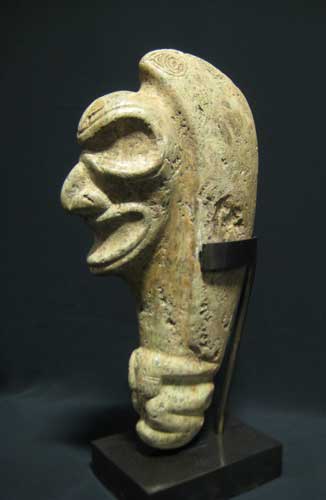Taino Stone Skull, 1000 CE - 1500 CE
Stone
7 x 12
LK.054
Taino communities were the first that Columbus encountered during his exploration of Hispaniola in 1492. Traditional Pre-Columbian scholarship focused on the mainland societies of the Incas, Aztecs and Maya, but...
Taino communities were the first that Columbus encountered during his exploration of Hispaniola in 1492. Traditional Pre-Columbian scholarship focused on the mainland societies of the Incas, Aztecs and Maya, but since the 1950s there has been growing awareness that Taino culture was highly sophisticated and deserves more detailed study. Politically, the Taino were divided up into separate communities ruled by chieftains (caciques) whose power had increased considerably by the time of the Spanish arrival. Religiously, the Taino were polytheistic and worshipped a pantheon of gods who were believed to control the natural elements. Ancestor worship was also important and the deification of deceased chieftains reinforced the political authority of their successors. An elaborate ritual system was developed to honour and placate these deities (zemis) and this probably provides the context for the present piece.
The shape of this stone carving is unusual and its function is not immediately clear. It may have been attached to a wooden shaft and used as a ceremonial axe or sceptre. The front depicts a human face with skeletal features. The eye-sockets are deeply carved and linked by the opening that runs across the bridge of the large, protruding nose. The wide grimacing mouth is typical of Taino zemi sculptures, as is the squatting position indicated at the base of the sculpture. The proportions of the body have been deliberately distorted to dramatic effect. At the end of the long neck (?), the hands rest upon the knees, and the lower legs are tucked tightly under the body. This was a position customarily assumed by Taino shamans when they attempted to contact the souls of deceased ancestors. This was only possible after they entered a trance-like state induced through the inhalation of the hallucinogenic cohoba. This sculpture encapsulates the inventiveness and dynamism that typify Taino art-forms and offers a glimpse into the mysteries of their religious ritual. (AM)
The shape of this stone carving is unusual and its function is not immediately clear. It may have been attached to a wooden shaft and used as a ceremonial axe or sceptre. The front depicts a human face with skeletal features. The eye-sockets are deeply carved and linked by the opening that runs across the bridge of the large, protruding nose. The wide grimacing mouth is typical of Taino zemi sculptures, as is the squatting position indicated at the base of the sculpture. The proportions of the body have been deliberately distorted to dramatic effect. At the end of the long neck (?), the hands rest upon the knees, and the lower legs are tucked tightly under the body. This was a position customarily assumed by Taino shamans when they attempted to contact the souls of deceased ancestors. This was only possible after they entered a trance-like state induced through the inhalation of the hallucinogenic cohoba. This sculpture encapsulates the inventiveness and dynamism that typify Taino art-forms and offers a glimpse into the mysteries of their religious ritual. (AM)
